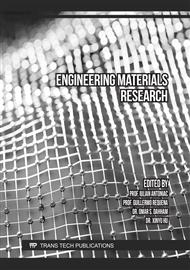[1]
Zaky AI, El-Morsy A, El-Bitar T. Effect of different cooling rates on thermomechanically processed high-strength rebar steel. Journal of Materials Processing Technology, 209(3), PP: 1565-1569, 2009. https://doi.org/10.1016/j.jmatprotec.2008.04.011.
DOI: 10.1016/j.jmatprotec.2008.04.011
Google Scholar
[2]
Ahmad M S. Effect of Sustained Elevated Temperature on Mechanical Behavior of Reinforcing Bar. Procedia Engineering, 173, PP: 905-909, 2017. https://doi.org/10.1016/j.proeng.2016.12.139.
DOI: 10.1016/j.proeng.2016.12.139
Google Scholar
[3]
Gardner L, Bu Y, Francis P, et al. Elevated temperature material properties of stainless steel reinforcing bar. Construction and Building Materials, 114, PP: 977-997, 2016. https://doi.org/10.1016/j.conbuildmat.2016.04.009.
DOI: 10.1016/j.conbuildmat.2016.04.009
Google Scholar
[4]
Xiao J, Hou Y, Huang Z. Beam test on bond behavior between high-grade rebar and high-strength concrete after elevated temperatures. Fire Safety Journal, 69, PP: 23-35, 2014. https://doi.org/10.1016/j.firesaf.2014.07.001.
DOI: 10.1016/j.firesaf.2014.07.001
Google Scholar
[5]
Li L J, Huo X D, Guo L. Strengthening Mechanisms of Vanadium Micro-Alloyed Reinforcing Steel Bar. Applied Mechanics and Materials, 130, PP: 942-945, 2011. https://doi.org/10.4028/www.scientific.net/AMM.130-134.942.
DOI: 10.4028/www.scientific.net/amm.130-134.942
Google Scholar
[6]
Lv Y K, Sheng G M, Huang Z H. High strain and low cycle fatigue behaviors of rebars produced by QST and V-N microalloying technology. Construction and Building Materials, 48, PP: 67-73, 2013. https://doi.org/10.1016/j.conbuildmat.2013.06.085.
DOI: 10.1016/j.conbuildmat.2013.06.085
Google Scholar
[7]
Lv Y K, Sheng G M, Jiao Y J. Effect of V/N ratio on the high strain and low cycle fatigue behaviors of V-N microalloyedrebars. Construction and Building Materials, 69, PP: 18-25, 2014. https://doi.org/10.1016/j.conbuildmat.2014.06.047.
DOI: 10.1016/j.conbuildmat.2014.06.047
Google Scholar
[8]
Wei J, Dong J H, Ke W. Corrosion resistant performance of a chemical quenched rebar in concrete. Construction and Building Materials, 25(3), PP: 1243-1247, 2011. https://doi.org/10.1016/ j.conbuildmat.2010.09.029.
DOI: 10.1016/j.conbuildmat.2010.09.029
Google Scholar
[9]
Wei J, Dong J H, Ke W. The influence of cooling processes on the corrosion performance of the rebar scale. Construction and Building Materials, 24(3), PP: 275-282, 2010. https://doi.org/10.1016/j.conbuildmat.2009.08.037.
DOI: 10.1016/j.conbuildmat.2009.08.037
Google Scholar
[10]
Ramesh S, Bhuvaneswari B, Palani G S, et al. Effects on corrosion resistance of rebar subjected to deep cryogenic treatment. Journal of Mechanical Science and Technology, 31(1), PP: 123-132, 2017. https://doi.org/10.1007/s12206-016-1211-5.
DOI: 10.1007/s12206-016-1211-5
Google Scholar
[11]
German M, Pamin J. FEM simulations of cracking in RC beams due to corrosion progress. Archives of Civil and Mechanical Engineering, 15(4), PP: 1160-1172, 2015. https://doi.org/ 10.1016/j.acme.2014.12.010.
DOI: 10.1016/j.acme.2014.12.010
Google Scholar
[12]
Das B, Bakkar A, Khutia N, et al. Low Cycle Fatigue Performance Evaluation of TMT rebar. Materials Today: Proceedings, 4(2), PP: 2554-2563, 2017. https://doi.org/10.1016/j.matpr. 2017.02.109.
DOI: 10.1016/j.matpr.2017.02.109
Google Scholar
[13]
Maksimov S, Bashkova J, Maksimova A. Modernization of Technology and Equipment for Glass Fiber Reinforced Plastic Rebar Production. Procedia Engineering, 206, PP: 1337-1341, 2017. https://doi.org/10.1016/j.proeng.2017.10.641.
DOI: 10.1016/j.proeng.2017.10.641
Google Scholar
[14]
Liu X, Su L, Liu X H. Effect of DROF process on the temperature field and roll force. Advanced Materials Research, 941-944, PP: 1885-1889, 2014. https://doi.org/10.4028/www.scientific.net/ AMR.941-944.1885.
DOI: 10.4028/www.scientific.net/amr.941-944.1885
Google Scholar
[15]
Liu X, Feng G H, Qi Y H. The Effect of Direct Rolling of Without-heating process on the Microstructure and Properties of a 400 MPa Rebar. IOP Conference Series: Materials Science and Engineering, 317(1), PP: 012003, 2018. https://doi.org /10.1088/1757-899x/317/1/012003.
DOI: 10.1088/1757-899x/317/1/012003
Google Scholar



